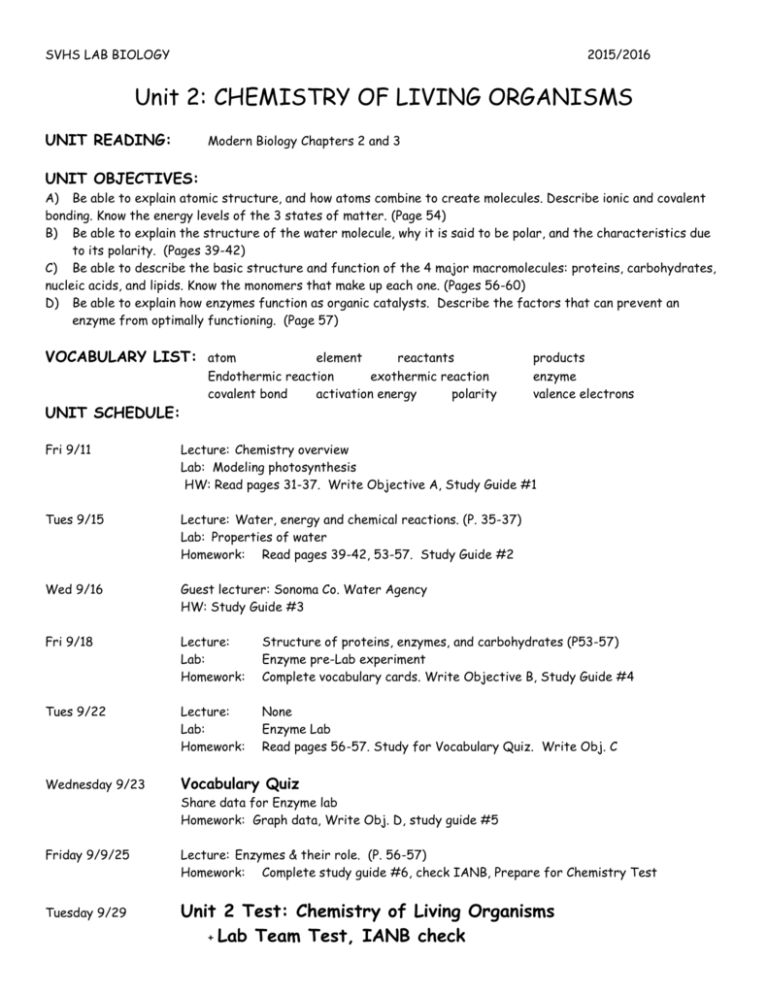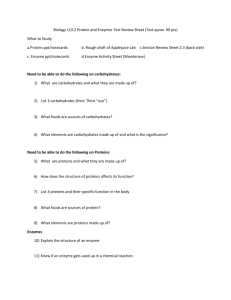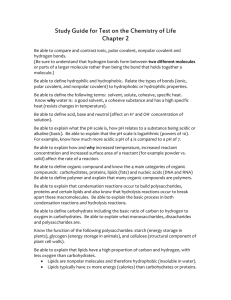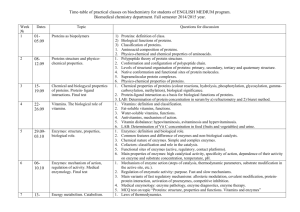Unit 2 Chemistry UDS lesson sheet 2015-2016
advertisement

SVHS LAB BIOLOGY 2015/2016 Unit 2: CHEMISTRY OF LIVING ORGANISMS UNIT READING: Modern Biology Chapters 2 and 3 UNIT OBJECTIVES: A) Be able to explain atomic structure, and how atoms combine to create molecules. Describe ionic and covalent bonding. Know the energy levels of the 3 states of matter. (Page 54) B) Be able to explain the structure of the water molecule, why it is said to be polar, and the characteristics due to its polarity. (Pages 39-42) C) Be able to describe the basic structure and function of the 4 major macromolecules: proteins, carbohydrates, nucleic acids, and lipids. Know the monomers that make up each one. (Pages 56-60) D) Be able to explain how enzymes function as organic catalysts. Describe the factors that can prevent an enzyme from optimally functioning. (Page 57) VOCABULARY LIST: atom UNIT SCHEDULE: element reactants Endothermic reaction exothermic reaction covalent bond activation energy polarity products enzyme valence electrons Fri 9/11 Lecture: Chemistry overview Lab: Modeling photosynthesis HW: Read pages 31-37. Write Objective A, Study Guide #1 Tues 9/15 Lecture: Water, energy and chemical reactions. (P. 35-37) Lab: Properties of water Homework: Read pages 39-42, 53-57. Study Guide #2 Wed 9/16 Guest lecturer: Sonoma Co. Water Agency HW: Study Guide #3 Fri 9/18 Lecture: Lab: Homework: Structure of proteins, enzymes, and carbohydrates (P53-57) Enzyme pre-Lab experiment Complete vocabulary cards. Write Objective B, Study Guide #4 Tues 9/22 Lecture: Lab: Homework: None Enzyme Lab Read pages 56-57. Study for Vocabulary Quiz. Write Obj. C Wednesday 9/23 Vocabulary Quiz Share data for Enzyme lab Homework: Graph data, Write Obj. D, study guide #5 Friday 9/9/25 Lecture: Enzymes & their role. (P. 56-57) Homework: Complete study guide #6, check IANB, Prepare for Chemistry Test Tuesday 9/29 Unit 2 Test: Chemistry of Living Organisms + Lab Team Test, IANB check SVHS LAB BIOLOGY CHEMISTRY OF LIVING ORGANISMS SELF STUDY GUIDE 1) After reading pages 31-34 titled “Composition of Matter”, be able to: A) B) C) D) Determine the most common elements in living organisms using the given mnemonic. Determine the atomic mass, number, # of electron shells, and outer shell electrons for these elements. Contrast ionic bonds and covalent bonds. Explain the octet or rule of eight relating to covalent bonds. 2) After reading pages 35-37 titled “Energy”, be able to: A) B) C) D) E) Define energy and free energy. Given a written chemical reaction, determine the reactants and the products. Contrast exergonic and endergonic chemical reactions. Explain the role of activation energy and catalysts. Contrast oxidation and reduction reactions regarding electron loss or gain. 3) After reading pages 39-42 titled “Water”, be able to: A) B) C) D) E) Explain the structure of water and what being polar means. Explain why water is a polar molecule. Explain why other polar compounds easily dissolves into water to form a solution. Explain what a hydrogen bond is and why they form. Explain cohesion, adhesion, capillarity, and temperature moderation regarding water. 4) After reading pages 51-54 titled “Carbon Compounds”, be able to: A) B) C) D) E) F) Define an organic compound. Explain how carbon bonding with other elements can form different shapes and #’s of bonds. Explain the role of functional groups. Contrast monomers and polymers (macromolecules). Contrast condensation reactions (dehydration synthesis) with hydrolysis. Explain how ATP stores and gives up energy for the cell’s use. 5) After reading pages 55-56 titled “Carbohydrates”, be able to: A) B) Describe the characteristics of carbohydrates. Contrast monosaccharide, disaccharide, and polysaccharide and give an example of each. 6) After reading pages 56-57 titled “Proteins”, be able to: A) B) C) D) E) Name the four elements that make up proteins. Describe the structure of an amino acid and how many are found in nature. Name the covalent bond that connects amino acids together to form proteins. Describe how protein molecules can differ and factors that can affect their shape or function. Explain the structure and function of enzymes as learned in the enzyme lab.











